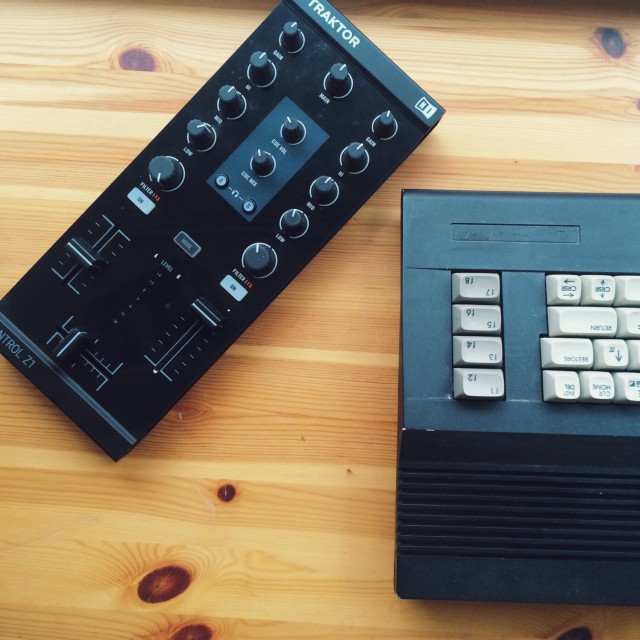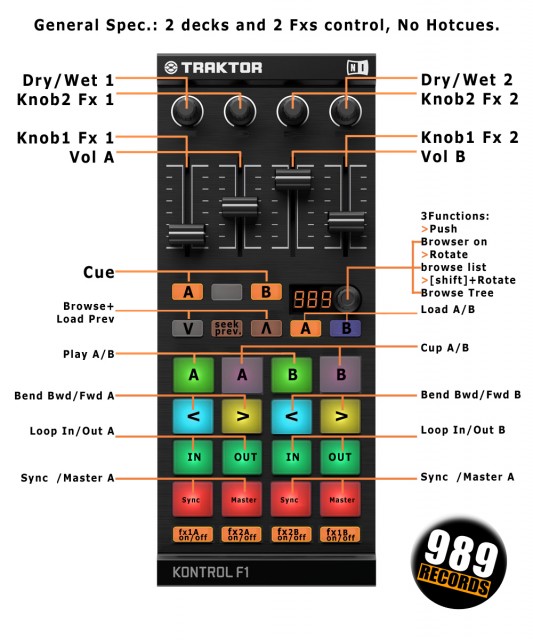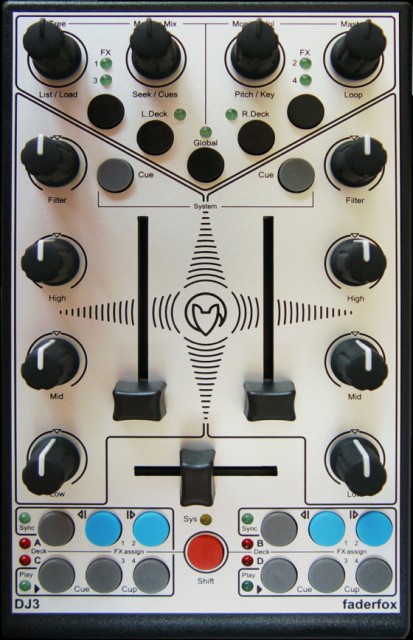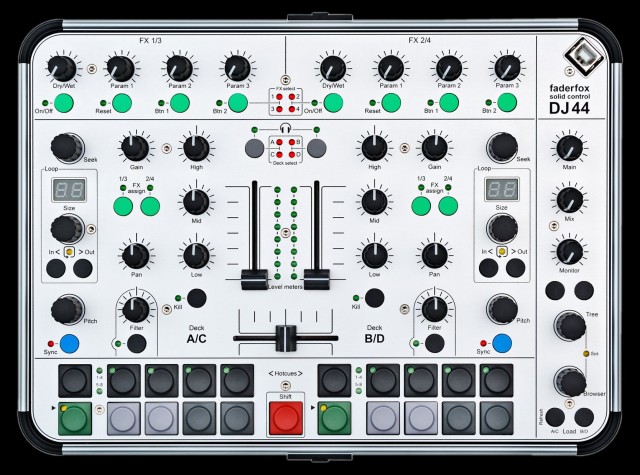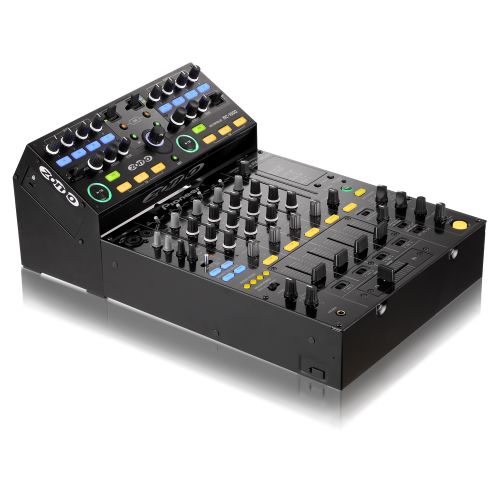How can you get the most hands-on control of a laptop DJ set when you don’t have a lot of room?
With so many of us called upon to DJ in a pinch – even as producers or live acts, onstage or in mixes – it’s relevant to almost anyone making electronic music.
And finding a way to stay mobile a worthy question – but one you might miss if following DJ blogs and music store displays. Imagine if you were making a generic DJ controller prop for a bedroom display at IKEA. You know exactly what it’d look like. It’d be the size of a coffee table (Lack!) and have a couple of giant wheels. Let’s call such things the Plastic Coffins.
That’s all fine and well – until you try to fit your controller into your backpack on easyJet. Or until you show up at a club and there’s barely enough room for your 13″ MacBook Pro.
Now, if you’re using CDJs or digital vinyl for control, you’ll presumably be okay; you mainly need only an audio interface. But if you want a self-contained setup, you’ll definitely need some controls.
There’s also the use case of being at home or on the road and needing to finish a mix or podcast. It’s nice to do this with proper controls, too.
So, I’ve selected a handful of DJ controllers I think stand out for these cases, partly because I’m surprised how often they’re eclipsed by the army of Plastic Coffins.
And I’m curious if Winter Music Conference shakes up this list.

Hrm. One of these looks … sort of … more viable outside the home. Photo CC-BY) DeeJay Jones.
I’ll focus here on Native Instruments’ Traktor, because it’s the software I see most in these situations. (Serato may rival Traktor for users, especially in the USA and Asia, but its inflexibility with controller mappings means you’re more likely to see Traktor in tight quarters.)
That said, if you are using one of the other DJ tools that isn’t Serato, most can be easily mapped to these controllers.
And if you think I’m an armchair DJ calling this without, say, racking up massive bookings at Ibiza alongside Richie Hawtin you are … absolutely right. So I’d better get these opinions themselves right.
I am largely ignoring the question of cueing. We can come up with various explanations: space is at a premium and you have to make sacrifices, you’d really rather beatmatch with actual turntables anyway, the sync button works pretty well for a lot of music, you’ve done some prep with cue points in advance… and so on. There’s a case for the touch strips, but we have to make some choices here.
My picks, in descending order:

Photo CC-BY) (JasonF from Hong Kong.
Traktor Kontrol Z1
This is, as far as I’m concerned, the single best hardware creation for mobile DJs ever.
It’s a controller for Traktor, as the name implies. It covers just the basics, but all the basics are covered: EQ, filter, cueing, 2-channel mixing controls (internal to the computer), and crossfader. With Traktor, you even get cute level meter indicators.
It’s also a controller for Traktor on the iPad, with the addition of a handy effects control (which I really wish also worked in the desktop version).
It’s an audio interface. Phono out, separate headphone out for cueing. And that audio interface, by the way, works for everything (it’s class-compliant). It works with the iPad – including cueing in Traktor for the iPad.
It’s a class-compliant MIDI controller. My Z1 has actually become my go-to controller for a lot of my Pure Data patches. (There are, I imagine, not many people on Earth swapping between Pd and Traktor Scratch Pro, but – yes, I’m sure all of you are reading this now. Get in touch, we should form some sort of secret society.)
If you need a two-channel audio interface headphone cueing or a controller with a slim two-channel DJ controller layout, the Z1 is for you, in other words – on any application, on any operating system, anywhere.
And if you’re using Traktor, it’s all an easy affair right out of the box. Everything feels perfectly solid for a piece of gear that costs nearly nothing.
Also worth considering is the Akai AMX. For Serato users, the AMX is your nearest Z1 equivalent, in that it includes an audio interface and controller in one slim-line box (and it is obviously a none-to-subtle Z1 homage from Akai and InMusic). It also does four deck control rather than two, and the one feature that might recommend it over the Z1 is that it includes dual phono inputs, not just stereo/headphone outs. I’m sticking with my Z1, as I like its more refined layout, but Serato users should be very happy indeed with the AMX and not experience even a pang of NI envy:
Serato DJs Get Slim-Line Controllers at Last, with New Akai Hardware
Native Instruments Kontrol F1
NI is about to take second place, too – but not for the reason they intended. The F1 is a cute sidecar to the Z1, and helped Native Instruments launch the Remix Decks. Read the manual: it’s kind of adorable, in that it just about pleads with you to please try to sample sounds into those decks. (At the time, the idea was new, and NI wasn’t yet selling its own packs.)
If you are a heavy Remix Deck user, the F1 will certainly make this list.
But lots of custom mappings mean the F1 will make the list even if you could care less about Remix Decks.
Ignore the silkscreened labels on the controller, and what the F1 is is impressively useful: RGB LEDs, faders, four knobs.
That’s an appealing layout for custom mappings. And if you can’t be bothered to set up one yourself, there are about a dozen reasonable mappings for this floating around forums for Traktor.
Here are my favorite pre-built mappings. They allow you to use the F1 alongside the Z1, or as an all-in-one, ultra-compact controller. And they will cover the gamut from basic mix controls to getting fancy with Remix Decks and live-style remix performances.
989 Records has a free download that transforms the F1 into a two-deck controller. Using an F1 and Z1 alongside one another, it’s a bit redundant, but then is a good starting place. Keep the effects controls, browse functions, and looping and cupping, and remap the redundant cue toggles and volume faders. (I might even share my own take on that.)
Free Traktor F1 Mapping – 2 Decks, Fxs and More
Michael Henderson aka DJ Endo is essentially the smartest Traktor user on the planet – clever enough that he’s the one training all the superstars, and that he made this powerful F1 mapping live at a gig and then played for hours. He’s the reason you ought to be afraid of Paris Hilton: with Endo working with Paris, the rest of us are the ones who will wind up looking clueless.
Endo’s approach with the F1 is basically to make it do everything. With faders grouped into four, it’s a four-deck controller, plus playing, looping, and hotcues. It also does beatjump and live-remix tools that may, frankly, be overkill for a lot of DJs. But you retain Remix Deck control.
It’s so fancy that it can be a little intimidating if your DJing is mainly about cueing and mixing, rather than live remixing. But the controls for navigating tracks are already useful; so long as you’re interested in four decks, it’s worth a look, and it’s just five bucks.
To get a sense of how someone who isn’t Endo uses this, there’s a great review:
Kontrol F1 4 Deck Mapping Review [traktortips]
Traktor F1 Deck [DJ Endo / MIDImonsters.com]
If you like this all-in-one approach, the Tekken Ultimate Mapping organizes everything into multiple pages and likewise covers more or less everything Traktor can do – Remix Decks stick around, but you get a lot of other functions, too. Added bonus here is a whole lot of instant effects, if you’re into that sort of thing. It’s a free download, but donations are suggested (and deserved).
Tekken’s Kontrol F1 Ultimate Mapping v3.2 [djtechtools]
It’s sort of the latest iteration of Endo’s approach, out just beginning of February.
Also, for would-be MIDI hackers: the F1, like the Z1, is a useful general-purpose MIDI controller. Not only will every control send MIDI to a computer (or tablet), but you can send MIDI back to the device to set RGB values for the pads. The pads aren’t velocity-sensitive, but that’s the only limitation. This means everyone from VJs to Max/Pd/Reaktor patchers can create powerful solutions with this device.
Runner up: Allen & Heath’s Xone:K1 is also a lovely controller. In fact, if I were judging purely on the basis of being a MIDI controller, it would probably edge out the F1. But it doesn’t have the larger grid of pads on the F1, which feel terrific, and the F1 is better suited to Traktor – both out of the box and in terms of community support. The K1 is worth considering if you’re mainly VJing or working with other DJ tools.
Honorable mention: I left out the Traktor Kontrol X1, even with the mk2 revision in the running. It’s nice, but I think its trackpads for cueing aren’t strictly necessary, and the F1 is more versatile if you have to choose – both in onboard control complement and user support.
If you do want to see someone who’s really good with the X1, though, turn to none other than Sarah Farina, as spotted here at Boiler Room:
And back to Serato users, if the X1 mk2 from Native Instruments had an evil twin at Akai, that’d be the AFX. Like the AMX to the Z1, Akai have squeezed more controls onboard the AFX – and even some small RGB pads for additional loop control and sampling.
Faderfox DJ3
It makes even the ultra-slim Z1 and F1 look huge. It’s nice looking – people will know you bought a boutique piece of gear. The controls are obsessive-compulsive German quality. It uses USB, and it’s class-compliant. And, oh, my, does the DJ3 fit a lot of controls into a small space.
Everything you really need is there. You get two-channel fader and crossfader, EQs, filters, effects, loops, pitch, key, cues. It does transport. It controls the browser.
In fact, you get everything the Z1 and F1 combined would do, meaning if you replace the Z1 with another audio interface, you have an even more compact setup.
Also, even with all of these capabilities, a lot is accessible even before you touch the shift key.
All of this is possible before any custom layouts, so I think given the complexity of some of those, this is a strong contender.
I dearly hope Faderfox keeps making these, as I think they’re utterly brilliant.
Runner up: If the DJ3 feels actually too cramped, trade up to Faderfox’s DJ44. It is tiny in all the ways Native Instruments’ own hardware isn’t. And it does away with any kind of touchpads or pad controller or giant wheels. As a result, it gives you dedicated controls for everything without being coffee table-sized.
And you still get four decks’ worth of controls, more mixing controls than anything else I’ve seen, loads of effects, and sophisticated dedicated loop controls.
In other words, the DJ44 is a no-gimmick embodiment of how a lot of average users actually DJ. And it all comes in a nice metal briefcase, James Bond style.
It’s even smaller than you think: 290x220x55 mm – that’s only slightly larger than the size of an American sheet of paper.
It’s not cheap, at 500€, but it’s a beautiful investment at that price – and works neatly with Ableton and Traktor alike, plus anything that supports MIDI. Even if you don’t own it forever, it won’t be because it broke or got outdated.
And it almost made this list, but for that price and the fact that it’s landscape orientation means you can’t sandwich it into a corner as easily as the other options here.
digitaldjtips has a nice DJ44 review; see also a video routine with the X1/Z1 (in German, but you can understand DJing in German)
An iPad, running TKFX
The iPad can make this list for a number of reasons:
Traktor for iPad is a beautiful piece of software, with touch access to slicing up loops that still bests the desktop software – even with the introduction of some of its functionality on the pricey, enormous Traktor Kontrol S8 hardware.
The Z1 and iPad make for an absurdly-mobile DJ solution, so long as you’ve an iPad with lots of internal storage and you don’t mind someone snickering at you for DJing on a tablet.
And with the addition of the Lemur app (among others), an iPad is a perfect do-everything controller for desktop Traktor, too. If you can’t be bothered to remember exactly which custom mapping went where (see above), you can take advantage of touching something that’s actually a screen.
I covered this concept in a Lemur app introduced nearly a year ago:
The Most Complete iPad Control of Traktor Yet: One Lemur Template Does Nearly Everything
That project has evolved into a huge app called Traxus Control (which for some reason two people didn’t understand was what I was referring to in the previous link – here you go). With this, you really don’t need other controllers, period (you could even replace the Z1 with something smaller):
Traxus Control
More than adding controls, it could change how you play, with fancy extras like sequencers running Remix Decks.
Here, though, to force myself to make one decision, I’m going to limit the iPad to running TKFX.
TKFX controls only the effects in Traktor. But by focusing on that use case, it’s better for effects control than anything else I’ve seen. For one thing, you can swap in different effects easily to your different decks and slots.
And TKFX takes everything you love about a KORG KAOSS Pad – X/Y control, gesture recording, freeze mode – and adds it to Traktor.
TKFX works over a cable, too, so you don’t have to rely on WiFi. It’s also compatible with midimux, the powerful MIDI solution we’ve covered here.
Honorable Mention: Zomo MC-1000
I didn’t actually even know about this hardware until it showed up in the studio one day. It makes this list in honorable mention position for one simple reason: it represents a different approach from the other options here. It relies so heavily on an external mixer that it actually packs an 8-channel audio interface in the box, and an optional rack mount lets you easily put it above a mixer.
With the mixer doing all the actual mixing, the MC-1000 handles effects and filter controls, and, primarily, cue and transport – up to four deck’s worth.
I like the approach, and it’s stupidly cheap – the price has cut down to 100€, meaning it’s almost hard to resist buying just to try out. But I’m obligated to take points off here because what it lacks is meaningful documentation. And unlike the other options here, it doesn’t fit the self-contained setup brief. But it’d be interesting to see other hardware go this route.
djworx review from 2012 – they liked it then, and it wasn’t dirt cheap then.
Demo video (some unpleasant music here in the opening, fair warning):
Honorable Mention: Anything Else with Faders
I should say, it’s very handy to have these controllers with a DJ app. They’re laid out in a way that’s very logical for the main mixing and cueing you might do. Once the basics are taken care of, however, you might do well to simply grab some MIDI controller that’s lying about and start assigning faders to effects you want to use in a gig. (KORG’s ultra-svelte nanoKONTROL comes up in comments; I like my Faderfox UC3 – and it’d go well with the aforementioned DJ3. See also Doepfer’s fader boxes, or the various smaller M-Audio controllers. And quite a lot of others – but I’m restricting myself to the most compact options here.)
Additional Honorable Mention: The Digital Warrior pioneered the notion of sequencing Remix Decks in hardware, and it’s open source. Unfortunately, it’s also discontinued for the moment, but I hope this sees a second life. DJ TechTools cloned this mapping with the Twister, but the Digital Warrior is open hardware and has more dedicated controls – and deserves credit for introducing the concept and Remix Deck mappings.
Go ahead – argue
Using other controllers in your mobile rig?
Using a DJ tool other than Traktor?
Got a favorite mapping or other tool you’ve found or built?
I’d love to hear about how you DJ, and how you use these tools. Do let us know in comments or talk to us on Facebook.
Addendum – just a crossfader?
If you want something truly compact, Mixfader is a Bluetooth wireless crossfader for mobile devices.
And that’s… um… not really terribly useful that I can see, but maybe I’m missing something? (I’ll stick with the Z1, which doubles as an audio interface, has essential mix, EQ, filter, and on iOS effects controls, and lets you queue. Also, you might want wires to connect to the PA, anyway.)
As seen on DJWORX.
